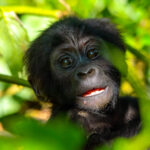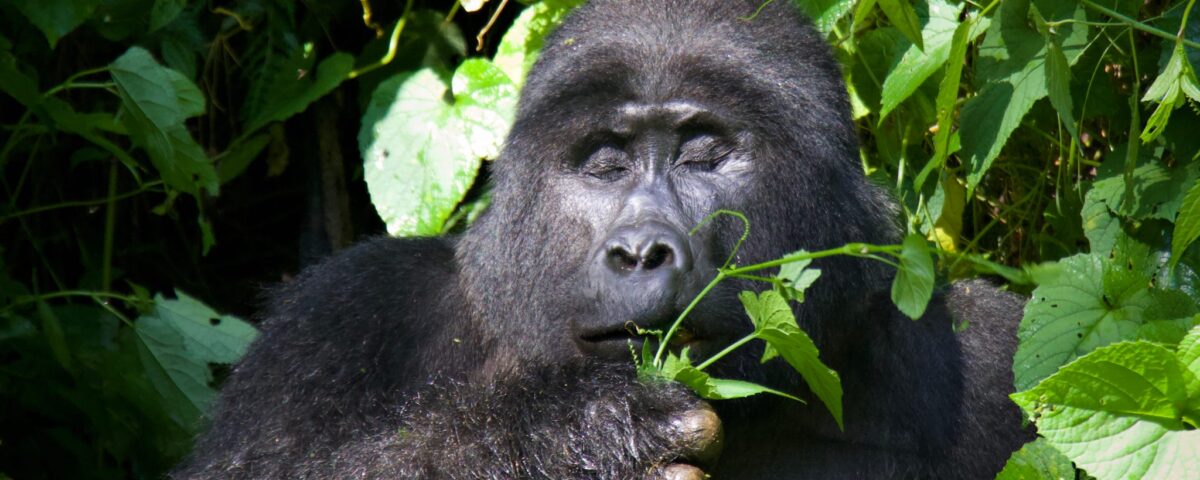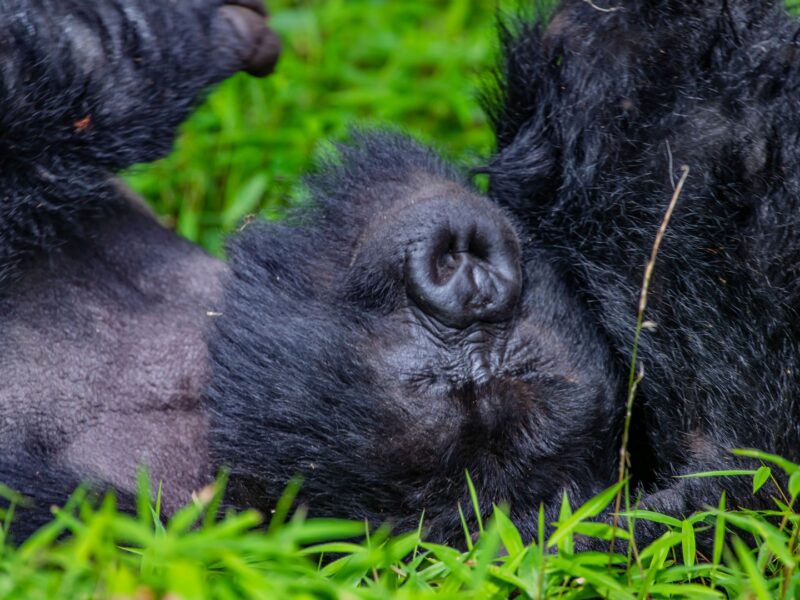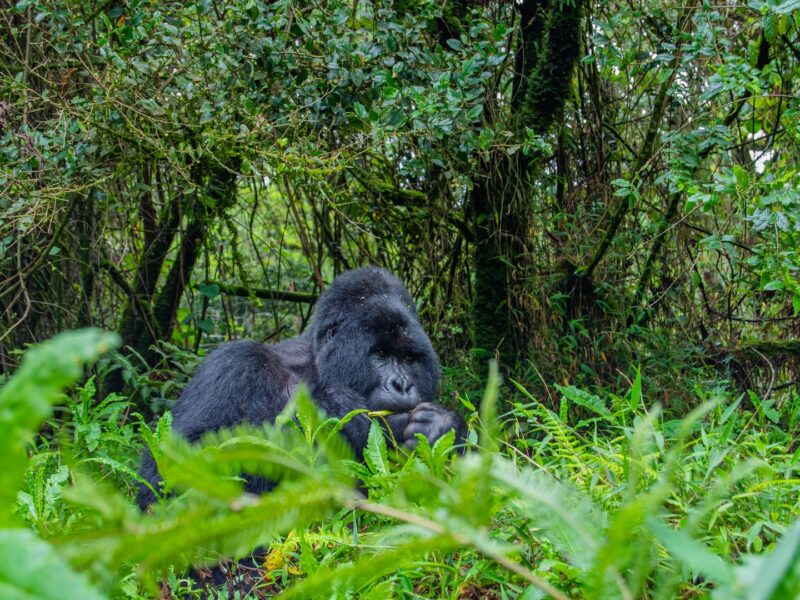
Gorilla Trekking for Seniors and Persons with Disabilities
July 18, 2025
What Is the Difference Between Gorillas and Chimpanzees?
July 22, 2025How Big Do Gorillas Get? The True Size and Power of Africa’s Gentle Giants
By Ngeye Tours & Travel
When travelers embark on a Uganda gorilla trekking adventure especially in the depths of Bwindi Impenetrable National Park one of the most frequently asked questions is: “How big do gorillas get?” These gentle giants, so often shrouded in mist and myth, have long captured human imagination. But their real size and strength are even more impressive.
Gorillas are the largest living primates on Earth. They are primarily herbivorous and inhabit the tropical forests of equatorial Africa, including Uganda, Rwanda, and the Democratic Republic of Congo. Uganda alone is home to over 50% of the world’s mountain gorilla population, primarily residing in Bwindi Impenetrable Forest and Mgahinga Gorilla National Park. These ancient rainforests, nurtured by the equator and rich biodiversity, provide a sanctuary where gorillas can thrive feeding, nesting, and interacting with their families in peace.
The gorilla genus is divided into two species: the Eastern gorilla (which includes the Mountain Gorilla) and the Western gorilla. Each has its own unique adaptations, but it is the Mountain Gorillas of Uganda that draw adventurers from around the world to the heart of East Africa for life-changing gorilla trekking safaris. Understanding their physicality offers not only awe but also an appreciation of the delicate balance that conservation efforts work tirelessly to preserve.
How Tall Are Silverback Gorillas in the Wild?
During your Uganda gorilla safari, you may encounter the iconic silverback—the dominant male and protector of the group. Silverbacks are aptly named for the silvery patch of hair that develops across their backs as they mature. These males are not just symbolic figures; they are massive beings with commanding presence.
On average, silverback gorillas stand between 5.5 to 6 feet (1.65–1.8 meters) tall when upright, and the tallest recorded silverback reached an astounding height of 1.95 meters (6 feet 5 inches). This places them among the tallest great apes in the world. However, unlike humans who walk fully upright, gorillas primarily move using knuckle-walking, which emphasizes their powerful upper bodies and long arms.
How Heavy Can Gorillas Get?
The size of gorillas isn’t just about height it’s about weight, bulk, and strength. An adult male silverback typically weighs between 135 to 220 kilograms (300–485 pounds).
In the lush ecosystems of Bwindi Impenetrable Forest, gorillas have access to an abundant vegetarian diet of leaves, stems, shoots, fruits, and bark. This nutrition supports their dense muscle mass and strong skeletal frames.
Their wide chests and massive shoulders are built not just for dominance but also for mobility in the dense, mountainous terrain of Bwindi. Watching one of these giants maneuver effortlessly through thick underbrush is a true marvel it’s like watching raw power in perfect harmony with nature.
Are Gorillas Really That Strong?
Absolutely and it’s not an exaggeration. Scientific estimates suggest that gorillas are 4 to 10 times stronger than the average human, depending on the task. Their upper body strength is especially notable, allowing them to pull, climb, and break thick vegetation with ease plus their robust skeletons and musculature aren’t just for show; they are built for survival in a challenging, ever-changing forest landscape.
Their arms are longer than their legs, a trait that aids in knuckle-walking, tree climbing, and maintaining balance across steep terrain. In Bwindi’s highlands and rugged valleys, this adaptability is crucial. Visitors on Uganda gorilla tours often observe silverbacks climbing steep embankments or clearing paths for their family members a demonstration of strength, leadership, and care.
Despite their power, gorillas are incredibly peaceful. They use their strength sparingly and prefer posturing and vocalizations over aggression. Watching a silverback drum his chest in warning is thrilling, but it’s rarely followed by violence. Gorilla behavior is social, calculated, and deeply nuanced. This is one reason gorilla trekking safaris emphasize respectful observation to ensure these sensitive animals remain unthreatened by human presence.
Where Can You See the Largest Gorillas in the Wild?
If you’re looking to witness the largest primates on Earth in their natural habitat, Uganda is the best place to go. Specifically, Bwindi Impenetrable National Park stands as the crown jewel of Africa gorilla trekking. This UNESCO World Heritage Site is home to nearly half of the world’s remaining mountain gorillas and offers one of the most immersive and ethically managed trekking experiences.
Bwindi boasts four main trekking sectors: Buhoma, Ruhija, Rushaga, and Nkuringo each offering distinct terrain, flora, and gorilla families to visit. With expert rangers and community involvement (including cultural exchanges with the indigenous Batwa pygmies, once forest dwellers themselves), a trek in Bwindi is more than just a walk it’s a journey into ancient biodiversity and human history.
For those with extra time, Uganda offers gorilla trekking in Mgahinga Gorilla National Park as well. This park lies along the Virunga Range, bordering Rwanda and the DRC, making it a great addition for multi-country adventures.
What Can You Combine With Gorilla Trekking in Uganda?
At Ngeye Tours & Travel, we believe that gorilla trekking should be part of a broader, enriching experience. Many travelers combine their Uganda gorilla safari with:
- Batwa Cultural Tours: Explore the traditions and stories of the Batwa, the original forest people, and gain deeper context into the region’s human-wildlife coexistence.
- Golden Monkey Tracking: In Mgahinga, enjoy tracking these playful, rare monkeys found only in the Virunga ranges.
- Bird Watching in Bwindi: This forest is a birding paradise with over 350 species, including Albertine Rift endemics.
- Lake Bunyonyi Relaxation: After trekking, unwind by this crater lake with canoeing, swimming, and island hikes.
- Queen Elizabeth National Park Safari: Spot lions, elephants, hippos, and more in one of Uganda’s most diverse parks.
- Chimpanzee Tracking in Kibale Forest: Meet our closest relatives on another thrilling primate adventure.
These activities offer the perfect balance of adventure, culture, and wildlife, making Uganda the best gorilla trekking safari destination in Africa.
At Ngeye Tours & Travel, we invite you to meet these magnificent creatures not just with your camera but with your heart. The experience will stay with you forever





